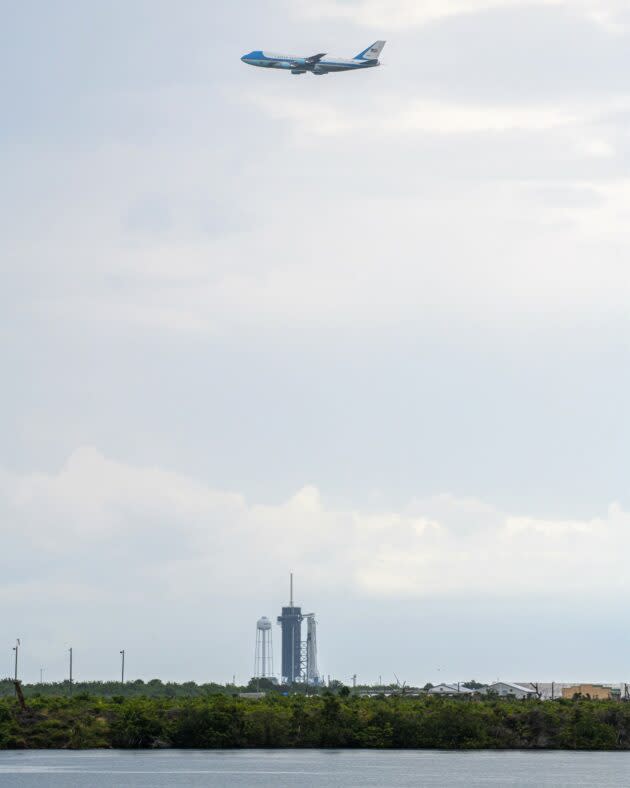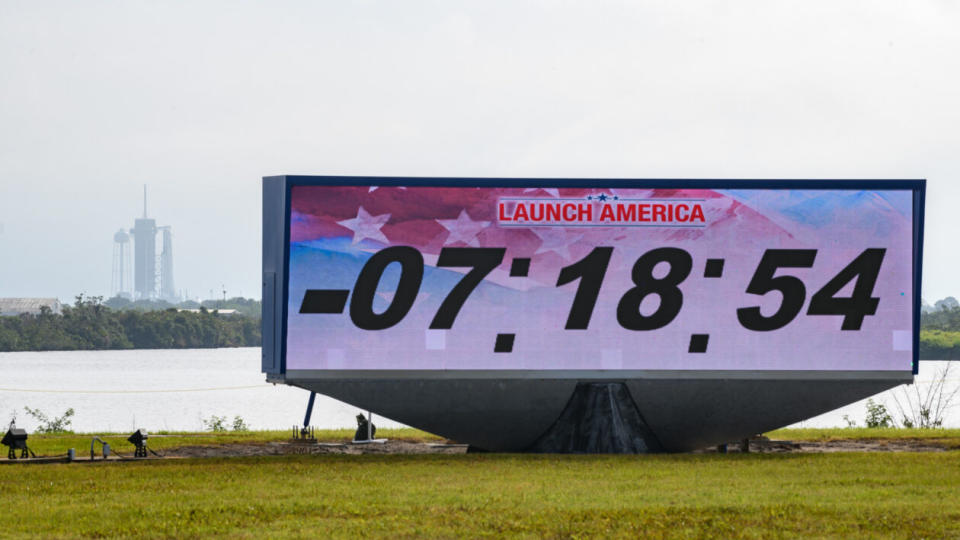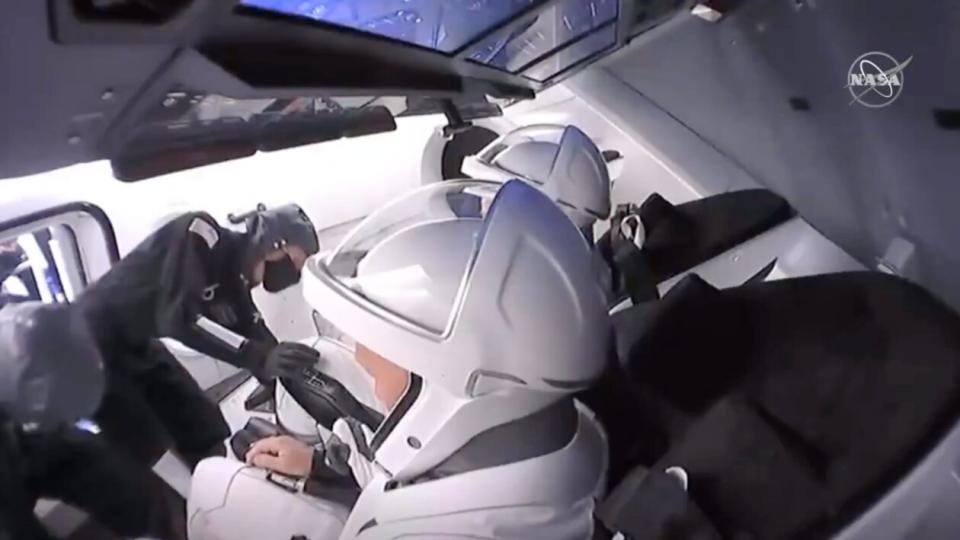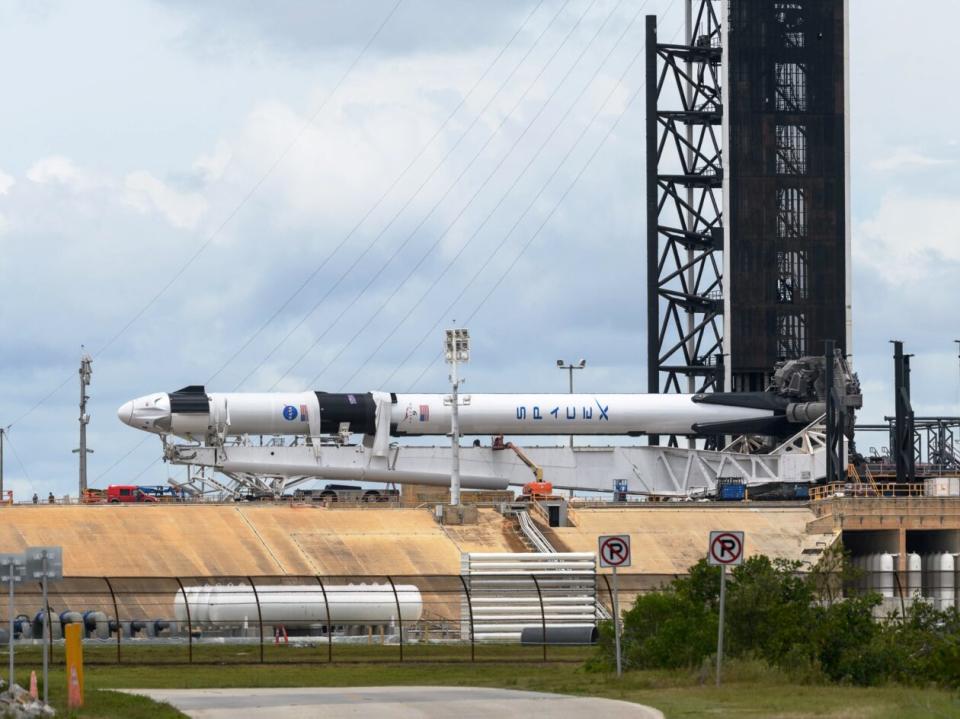Weather forces delay for SpaceX’s historic launch of NASA’s first Dragon riders to the space station

The countdown for SpaceX’s first crewed launch to the International Space Station ran down to less than 17 minutes, but because the weather didn’t cooperate, history will have to wait until Saturday at the earliest.
SpaceX called off the launch of its Falcon 9 rocket with NASA astronauts Doug Hurley and Bob Behnken sitting inside the Crew Dragon capsule on top, and President Donald Trump and Vice President Mike Pence waiting in the wings. Liftoff would have marked the first-ever use of a privately owned spaceship for a crewed orbital launch, the first launch of NASA astronauts from U.S. soil since the space shuttles were retired in 2011, and the official start of a renaissance for U.S. spaceflight.
But dark clouds and rain swept over the launch pad at NASA’s Kennedy Space Center in Florida throughout the day. Tropical Storm Bertha battered the Carolina coast to the north. And conditions were also dicey out in the Atlantic Ocean, where Hurley and Behnken would have to make a splashdown if an emergency arose during their ascent to orbit.
There was enough hope to start fueling up the Falcon 9, but not enough to proceed to the launch. At one point, a member of the launch team was heard remarking that an extra 10 minutes could have made a difference. The problem was, the rocket had to blast off at 4:33 p.m. ET (1:33 p.m. PT) or hold off for the next opportunity.
A couple of minutes later, SpaceX launch director Mike Taylor broke the bad news to the crew. “Unfortunately, we are not going to launch today,” he said.
“It was a good effort by the teams, and we understand,” Hurley replied.
While the VIPs headed off to their next engagements, members of the combined NASA and SpaceX team wrapped things up for today’s attempt and started thinking about the next one, scheduled for 3:22 p.m. ET (12:22 p.m. PT) Saturday. There’s another launch opportunity set for Sunday.
In-person viewing of the launch was restricted due to concerns about the coronavirus pandemic, but more than 2.5 million people watched today’s proceedings online. Streaming coverage of the next attempt will start at 11 a.m. ET (8 a.m. PT) Saturday on NASA’s and SpaceX’s YouTube channels. Trump tweeted that he’d be back for the milestone launch.
Before today’s scrub, NASA Administrator Jim Bridenstine and SpaceX CEO Elon Musk made note of the mission’s meaning.
“We are once again launching American astronauts on American rockets from American soil, and this is a big moment in time,” NASA Administrator Jim Bridenstine declared during a launch-eve briefing.
“This is a dream come true, for me and for everyone at SpaceX,” Elon Musk, the California-based company’s CEO, told a NASA interviewer as he waited for liftoff. “This is not something that I ever thought would actually happen. … It’s really hard to believe that this is real.”
Musk said he spoke with the astronauts’ families before Hurley and Behnken headed to the launch pad, and told their children: “We’ve done everything we can to make sure your dad’s coming back OK.”
The Crew Dragon is equipped with a launch escape system that would blast the capsule away from its rocket if something went wrong during liftoff. A new type of parachute system was developed and tested to ensure a safe descent, and a fleet of vessels was standing by in the Atlantic to recover the crew in the event of an emergency splashdown. SpaceX had other ships primed to try recovering the Falcon 9’s first-stage booster and nose cone.
All those arrangements will come into play again on Saturday, when the weather forecast shows only a 40% chance of acceptable conditions for launch.
“We’re going to feel a lot of deja vu, I think, on Saturday,” said NASA launch commentator Dan Huot.
A test pilot’s dream
If the launch takes place on Saturday, Hurley and Behnken would arrive at the space station on Sunday.
They’re scheduled to spend somewhere between six and 16 weeks on the station, living and working alongside NASA crewmate Chris Cassidy and Russian cosmonauts Anatoly Ivanishin and Ivan Vagner. Because of the uncertainties surrounding their test mission, it’s not yet clear what duties the Dragon riders will take on. But with years of training under their belt, they should be ready for anything. Behnken has even been trained to take on a spacewalk if needed.
At the end of their tour of duty, Hurley and Behnken will climb back into the Crew Dragon for the descent to an Atlantic Ocean splashdown and recovery. Then NASA will assess the spacecraft’s performance, work with SpaceX to make tweaks if necessary, and get set to launch another crew on a different Dragon.
Hurley and Behnken are both veteran military test pilots with space shuttle experience. During a pre-launch news conference, Behnken said he was excited to be one of the first people to fly on a Crew Dragon. “It’s probably the dream of every test pilot school student to have the opportunity to fly on a brand new spaceship, and I’m lucky to get that opportunity with my good friend here,” he said.
Hurley was the pilot on the shuttle Atlantis’ mission to the space station in 2011, which closed out the 30-year shuttle program. During that flight, Atlantis’ crew left behind a U.S. flag that was reserved for the next crew to arrive at the space station after a launch from Florida. Now he’s in line to retrieve that same flag.
“We’ll bring it back when we come back later this summer,” Hurley said.
Since Hurley’s previous flight, NASA has had to pay the Russians up to $80 million a seat to have its astronauts ferried back and forth from the space station on Soyuz spacecraft. If the Crew Dragon demonstration mission is successful, NASA will essentially be paying U.S. companies for space taxi rides instead. Any future Soyuz rides will be arranged on a barter basis.
14 years of space commercialization
Replacing NASA’s old space shuttles was no easy or quick task: The job actually started back in 2006, when NASA made its first selections for commercial cargo transport services. With NASA’s financial support, SpaceX developed a first-generation, uncrewed Dragon capsule to serve those cargo needs. (Another cargo capsule called the Cygnus was built by Orbital Sciences, which is now part of Northrop Grumman.)
In 2014, SpaceX and Boeing were selected to provide more capable space taxis that would have all the safety features required for crewed flight. SpaceX upgraded its cargo-capable Dragon to accommodate crew, while Boeing built a new type of capsule called Starliner.
Both SpaceX and Boeing suffered setbacks. SpaceX notched a success with an uncrewed Crew Dragon demonstration mission to the space station and back in March 2019, but just weeks later, the Dragon erupted in fire during a test of its thrusters. The propulsion system had to be redesigned to fix the problem for good.
Last December, a software glitch spoiled Starliner’s uncrewed mission to the space station, forcing Boeing to take dozens of corrective actions. As a result, another uncrewed test mission will need to be flown, and Boeing seems certain to miss out on capturing the flag.
Although the spaceship development effort has taken longer than expected, NASA officials said in a recent report that the space agency got a relative bargain.
Phil McAllister, NASA’s director of commercial spaceflight, estimated that the space agency spent about $6 billion for the development of the two commercial crew transport systems .He said it would have cost $20 billion to $30 billion more for NASA to build its own system with similar capabilities.
That assessment suggests SpaceX CEO Elon Musk accurately predicted the future back in 2006 when he discussed what commercialization would mean for America’s space effort. “This is going to be the best value for money that NASA and the American taxpayers have ever received,” he told me at the time.
Theoretically, all those savings will free up NASA to set its sights beyond Earth orbit, to the moon and Mars. NASA has been spending tens of billions of dollars to build an Orion deep-space capsule as well as a heavy-lift rocket called the Space Launch System to send astronauts to the lunar surface by as early as 2024.
But at the same time, SpaceX and other launch companies are also setting their sights higher. SpaceX is currently developing a super-heavy-lift launch system called Starship, which Musk has said could be flying missions to the moon and Mars by the mid-2020s. Amazon CEO Jeff Bezos’ privately held space company, Blue Origin, has lunar ambitions as well.
Meanwhlle, both SpaceX and Boeing are making plans to fly their own customers on space taxis, perhaps including action hero Tom Cruise. NASA’s Bridenstine has said he welcomes the companies’ efforts to drum up more business.
“We are going to be one customer of many customers in a robust commercial marketplace,” he said last year.
So if all goes well with SpaceX’s first-ever crewed spaceflight, it may not be long before NASA isn’t the only one having Dragon riders sent into orbit.
This report was first published at 9:10 a.m. PT May 27 and his been updated frequently since then.









